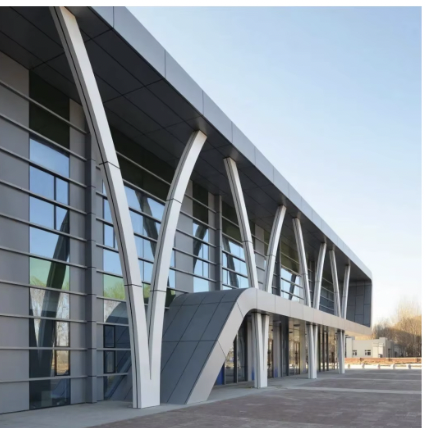The Critical Role of Steel in Public Building Construction
Steel Structure Buildings: Defining Modern Public Infrastructure
Steel buildings have become really important for cities these days, especially when it comes to creating strong and flexible public spaces. The construction industry has seen steel usage go up consistently over recent years, and steel frames now make up a bigger portion of building projects worldwide. Take what the World Steel Association found for example their research shows steel applications growing around 5% each year in construction work. We're seeing this trend everywhere from skyscrapers in major metropolitan areas to community centers in smaller towns. The reason? Steel just works better for many modern construction needs than traditional materials do. As cities continue expanding and infrastructure requirements evolve, steel remains at the forefront of architectural innovation and practicality.
Steel stands out as a top pick for durable public infrastructure because of how tough, eco-friendly, and adaptable it really is. When buildings need to handle harsh weather without falling apart, steel just keeps going strong year after year. What makes steel even better? It can actually be recycled again and again without any loss in quality, which cuts down on waste from construction sites. This means less strain on our planet while still getting solid structures built. The money saved over time adds up too since these buildings last longer and require fewer repairs. As cities around the world try to become greener places to live, choosing materials like steel helps meet those sustainability goals without sacrificing quality or safety.
Take One Angel Square in Manchester as proof of what steel can do for public buildings. Built with steel frames, this project cut down on construction time and saved money over its lifetime. Completed before deadline meant faster returns for investors, plus they needed fewer materials because steel is both strong and lightweight. Looking at projects like this shows why steel structures work so well for cities growing fast. They save cash in the long run too. When we look at all these real world examples, one thing becomes clear: steel isn't just supporting our skylines, it's actually holding up entire communities with its durability and efficiency.
Structural Integrity Through Proper Load Distribution
Engineering Principles for Stress Management
Getting a good grasp on how stress works in steel structures matters a lot when it comes to keeping buildings standing strong. At the heart of this are two main ideas tension and compression forces that determine where weight gets distributed properly throughout any given structure. Most engineers today rely heavily on something called Finite Element Analysis, or FEA for short, during their design process. Basically, FEA lets them see exactly where stresses might build up under different conditions before construction even starts. Without these simulations, unexpected failures could happen down the road from hidden pressure points nobody saw coming. The field keeps evolving too, so many professionals make sure they keep learning new methods and materials regularly. After all, nobody wants to deal with expensive repairs caused by poor load calculations later on.
Preventing Structural Fatigue in High-Traffic Areas
Public buildings face serious issues with structural fatigue, particularly where lots of people walk through daily. What happens is pretty straightforward really materials get stressed repeatedly until they start failing. This gradual breakdown poses real safety problems if left unchecked. Keeping up with regular maintenance checks and incorporating smarter designs goes a long way toward extending how long structures stay safe. Some newer materials actually handle weight distribution much better than traditional ones, reducing those fatigue risks considerably. We've seen plenty of cases where ignoring these signs led to major failures across different kinds of construction projects. The numbers back this up too recent studies show buildings maintained properly have failure rates around 40% lower than neglected ones. That's why ongoing inspections matter so much for places like schools, hospitals, and shopping centers where constant foot traffic takes its toll day after day.
Ensuring Long-Term Safety with Precision Welding
Getting precision right in welding work stands at the heart of building steel structures that last and keep people safe in public spaces. Most contractors rely on methods like MIG and TIG welding to create those solid connections between metal parts. But making sure these joints hold up requires constant vigilance when it comes to quality control. Inspectors need to check each weld thoroughly during construction to catch any defects early on. Why does this matter so much? Bad welding has caused major disasters before. Take the Champlain Tower incident as just one sad example where poor welding contributed to serious structural problems. That's why smart builders always allocate time and resources for proper inspection protocols and hire experienced welders who know what they're doing. The end result? Buildings that stand the test of time without compromising safety standards.
Bolting Methodologies for Seismic Resilience
Steel structures need good bolting methods if they're going to stand up to earthquakes, especially where quakes happen regularly. When engineers get the bolting right, buildings actually survive shaking events without losing their basic strength. Heavy duty bolts, expansion anchors, and pre-tensioning techniques help spread out the stress throughout connections between different parts of the structure. This makes it much less likely something will break when the ground starts moving. Following building codes like IBC and Eurocode isn't just paperwork either these rules contain real knowledge about what works best in practice. Contractors who ignore them end up with buildings that don't perform as expected during actual seismic events. Most experienced builders know from hard lessons that sticking to code requirements saves money and lives in the long run.
Environmental Performance and Comfort
Acoustic Insulation Techniques
Getting good acoustics right matters a lot in places where people gather, especially when we're talking about steel buildings. Steel isn't just strong and lasts forever, but architects have figured out ways to work with it so it helps control noise too. They stick acoustic panels inside walls or use special insulation stuff between layers of steel to keep unwanted sounds from bouncing around everywhere. Libraries need quiet spaces for reading, lecture halls require clear audio for presentations, and hospitals benefit from reduced background noise all over the place. Studies actually show that these methods cut down on disruptive noises by up to 40% in some cases. People who spend time in well-designed acoustic spaces report better focus during tasks and generally feel less stressed out. That makes sense when you think about how annoying constant background noise can get after while.
Thermal Efficiency in Steel Public Buildings
When it comes to steel public buildings, thermal efficiency plays a major role in both saving money and conserving energy over time. Getting this right means choosing the right materials and construction techniques that actually make a difference in how much heating and cooling the building needs throughout the year. Steel works well when combined with good insulation and reflective surfaces, which helps keep temperatures stable inside while cutting down on energy bills. Real world tests have shown that buildings designed with proper thermal management can cut operational costs by around 30% compared to standard constructions. For city planners and architects working on public projects, incorporating these thermal considerations makes sense from both environmental and budget perspectives. After all, nobody wants to pay for unnecessary energy waste in community spaces like libraries or government offices.

Regulatory Compliance and Code Adherence
Navigating International Building Standards
Getting familiar with international building standards makes all the difference when constructing steel structures. These buildings must meet different global standards across countries, and ignoring them can lead to serious safety issues down the road. The whole process starts long before construction actually begins. Architects need to weave these specific requirements right into their blueprints from day one. Take places like California and Japan as good examples where builders face strict rules because earthquakes are so common there. They need special designs that can withstand tremors without failing. Following these standards isn't just about avoiding disasters either. It actually speeds things up during approvals since authorities recognize compliant work immediately, which saves everyone time and money in the long run.
Documentation for Safety Certification
Getting safety certification for public buildings really depends on keeping good records throughout the whole process. Contractors need to document everything from blueprints and materials used to how things were actually built on site. These papers help ensure everyone follows safety rules and reduces potential problems down the road. Good documentation also builds confidence among taxpayers who want to know their money is being spent safely. Many contractors run into trouble when they forget to file important paperwork or organize it properly. When docs are complete and easy to find, the approval process moves much faster. Companies that stay organized tend to get permits quicker while creating an environment where safety becomes second nature across the construction industry.
FAQ
What are the advantages of using steel in public building construction?
Steel offers durability, sustainability, and versatility, making it ideal for public infrastructure. It withstands extreme weather and is recyclable, contributing to cost savings and ecological efficiency.
How does precision welding enhance the safety of steel structures?
Precision welding ensures strong joints and prevents structural failures. Regular inspections and skilled welding are crucial for the longevity and safety of buildings.
What role does bolting play in steel structures' seismic resilience?
Bolting methods distribute strain across joints, ensuring buildings withstand seismic forces without compromising their integrity.
Why is thermal efficiency important in steel public buildings?
Thermal efficiency reduces energy costs by optimizing temperature regulation, offering significant economic and sustainability benefits.






